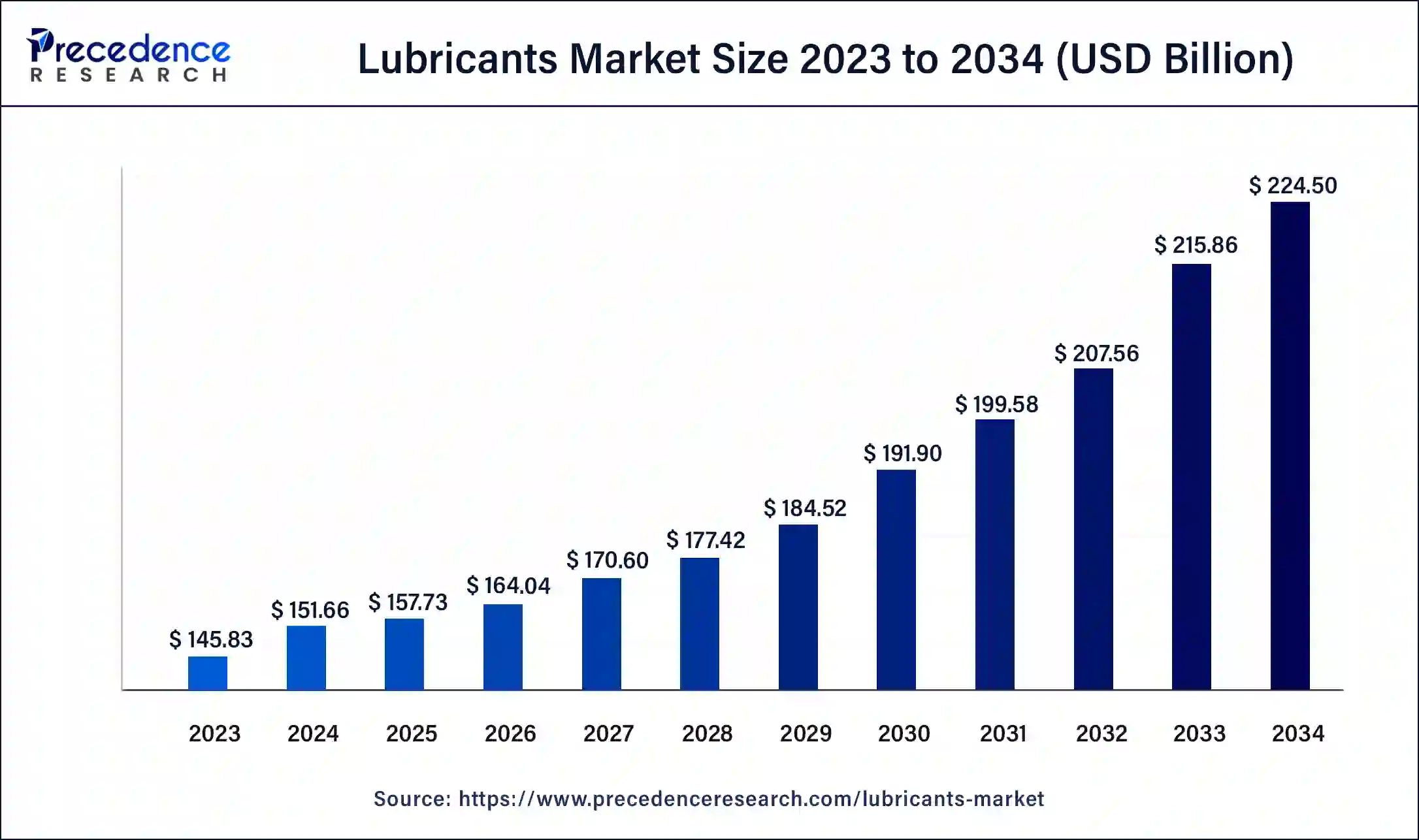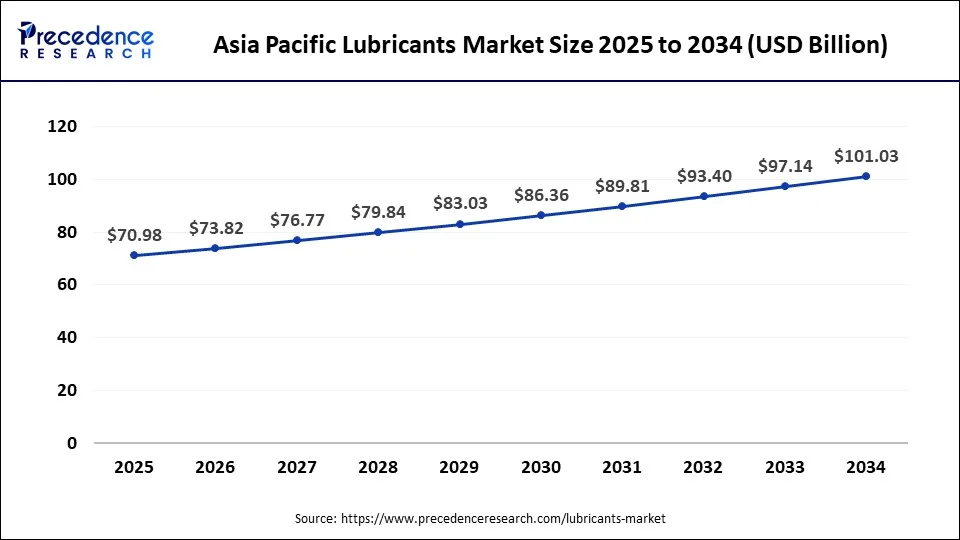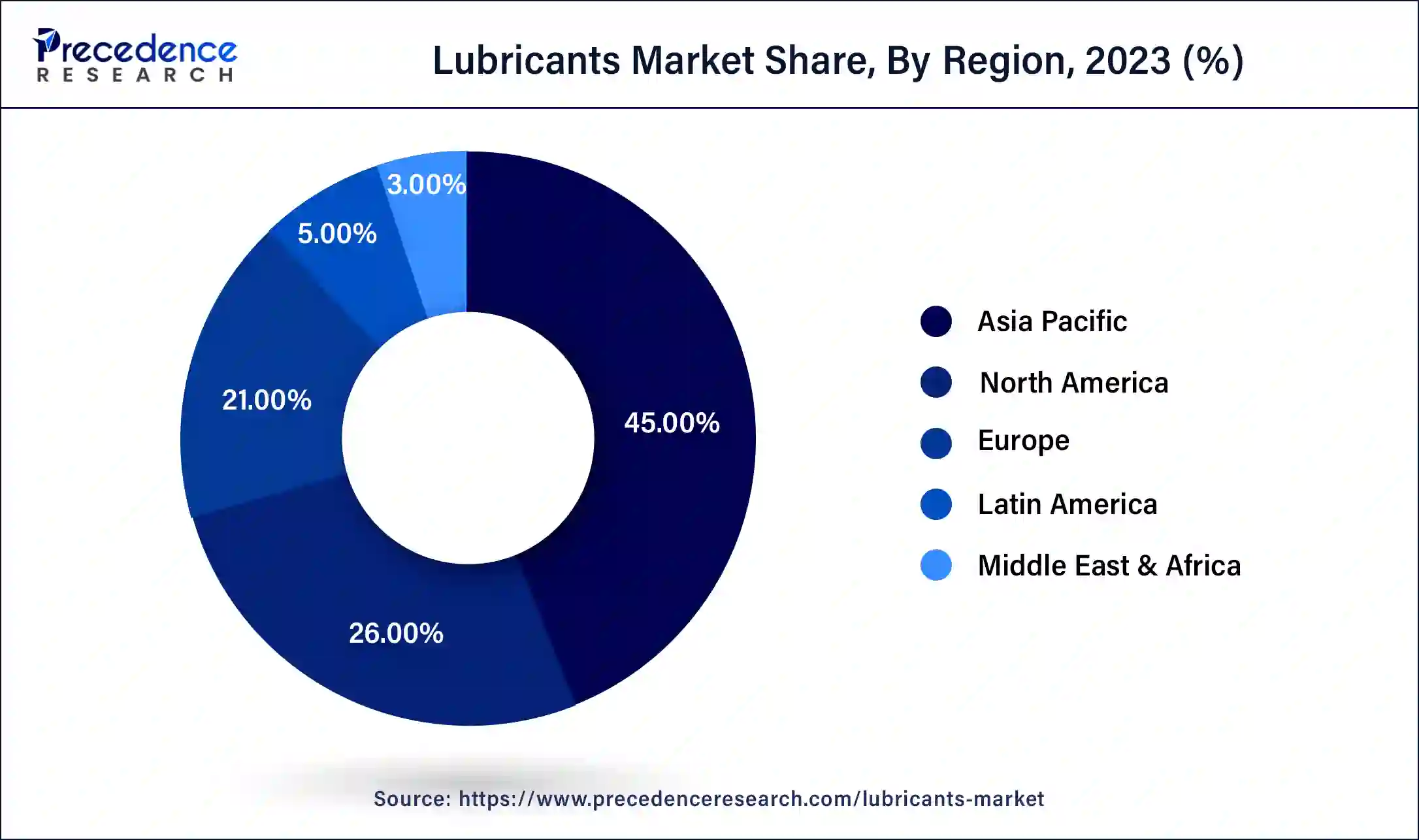Lubricants Market (By Application: Industrial, Automotive, Marine, Aerospace; By Base Oil: Mineral Oil, Synthetic Oil, Bio-based Oil) - Global Industry Analysis, Size, Share, Growth, Trends, Regional Outlook, and Forecast 2024-2034
The global lubricants market size was USD 145.83 billion in 2023, accounted for USD 151.66 billion in 2024, and is expected to reach around USD 224.50 billion by 2034, expanding at a CAGR of 4% from 2024 to 2034.

The Asia Pacific lubricants market size was estimated at USD 65.62 billion in 2023 and is predicted to be worth around USD 101.03 billion by 2034, at a CAGR of 4.2% from 2024 to 2034.

Asia-Pacific led the market with the biggest market share of 45% in 2023, capturing a significant revenue share. This growth is driven by the rapid expansion of the automotive industry, industrial development, and automotive manufacturing hubs in countries like Japan, India, and China. Predominantly used lubricants in the Asian market include automotive engine oils, greases, and hydraulic fluids. Major countries such as China, India, Japan, and South Korea contribute to demand. The market exhibits diversity due to swift industrialization, business sector expansion, and local vendors' presence.

Europe held a substantial revenue share in the lubricants market and is expected to experience a significant compound annual growth rate (CAGR) in the forecast period. The European Union (EU) automotive industry is one of the largest globally, playing a vital role in the region's economy. During the first three quarters of 2023, the EU produced over 9 million cars, marking a 14% increase compared to the previous year.
The lubricants market refers to the industry involved in the production, distribution, and sale of lubricating oils and greases. Lubricants are substances used to reduce friction, heat, and wear between moving parts in machinery and equipment, thereby extending their lifespan and improving efficiency. The lubricants market encompasses a wide range of applications across various industries, including automotive, industrial, marine, aerospace, construction, and agriculture. Depending on their application, Lubricants can transmit power, protect against damage, and eliminate wear and heat debris.
Liquid lubricants, categorized as mineral, synthetic, or semi-synthetic oils based on their base oil, typically contain additives to enhance performance. The effectiveness of lubricants relies on critical characteristics, with viscosity and density being the most significant attributes in lubrication theory. The primary goal of lubrication strategies is to create a lubricant layer that separates rubbing surfaces, preventing direct contact between the bodies involved.
| Report Coverage | Details |
| Global Market Size in 2023 | USD 145.83 Billion |
| Global Market Size in 2024 | USD 151.66 Billion |
| Global Market Size by 2034 | USD 224.50 Billion |
| Growth Rate from 2024 to 2034 | CAGR of 4% |
| Largest Market | Asia Pacific |
| Base Year | 2023 |
| Forecast Period | 2024 to 2034 |
| Segments Covered | By Application and By Base oil |
| Regions Covered | North America, Europe, Asia-Pacific, Latin America, and Middle East & Africa |
expansion of application in various sectors
In various industries, including construction, automotive, aerospace, agriculture, automotive, construction, marine, mining, oil drilling, steel and cement, and wind energy, lubricants play a crucial role. In construction, lubricants are crucial for their resistance to corrosion and anti-wear properties, which aid equipment like excavators and loaders.
The demand for lubricants is rising due to their unique qualities, primarily dependent on. Properties such as high boiling point, thermal stability, hydraulic stability, a high viscosity index, and oxidation resistance help reduce friction in various applications, increasing the global lubricant demand. The growing utilization of lubricants, driven by their superior properties, is expected to boost the market's growth rate.
Growing demand for lubricants in the automotive sector
Lubricants play a vital role in diverse industries, including automotive and industrial manufacturing, where their use has grown significantly. With the rapid expansion of industrial activities in many developing nations, companies employ machinery to meet their daily production needs. The rising demand for consumer goods necessitates increased raw material supply. Lubricants effectively blend with oil and act as a protective barrier, preventing impurities from causing damage to surfaces. This makes lubricants essential in meeting the demands of different end-user sectors, including the automotive industry and industrial manufacturing.
Rising demand for hybrid vehicles or battery-operated vehicles
The increasing adoption of battery-operated and hybrid vehicles is gradually reducing the demand for internal combustion engines (IC) in the automotive sector, significantly impacting lubricant demand in the forecast period. Strict vehicle emission standards and regional initiatives to ban diesel engines are substantial factors impeding the growth of the lubricants market in the forecast period.
Additionally, fluctuations in crude oil prices pose a significant challenge as the production of lubricants heavily relies on the fractioning process of crude oil. Mineral oil-based lubricants, a substantial part of the global market, are particularly affected by raw material fluctuations from the oil and gas industry, impacting the cost of marine lubricants.
Increasing research and development in the automotive sector
The global automotive industry has witnessed substantial growth driven by factors like increased market openness, the introduction of new vehicle models, easy access to low-interest financing, and price reductions by dealers and manufacturers. The past decade has seen a nearly twofold increase in passenger vehicle sales due to pent-up demand and expanded market access. The surge in demand for personal mobility, including traditional and advanced electric vehicles, has driven the need for improved components, leading to a heightened demand for lubricants.
Surging demand for bio-based lubricants
One of the recent trends in the global market is the increasing adoption of bio-based lubricants by end-users and manufacturers. These greener lubricants offer improved safety with more elevated flashpoints, even viscosity, and reduced vapor emissions and oil mist. Many vendors are emphasizing bioaccumulation and eco-toxicity to minimize adverse environmental impacts. Bio-based lubricants can help reduce pollution in stormwater from the engine, hydraulic systems, and brake line leaks.
Several European countries now mandate using bio-based lubricants in specific environmentally sensitive applications. Companies like RSC Bio Solutions, with their FUTERRA brand, offer plant-based lubricants. Castrol and FUCHS are also manufacturing eco-friendly lubricants. Bio-based lubricants degrade gradually, leaving minimal environmental traces, contributing to increased adoption and market focus during the forecast period.
In 2023, the automotive sector took the lead in the global lubricants market. This dominance results from increased sales of consumer vehicles, including buses and trucks. The surge in automobile production and demand, especially in developing nations like China, India, Brazil, and Indonesia, has propelled the lubricants market. The growing preference for passenger cars, particularly in the mentioned countries, is set to expand the automotive industry, subsequently boosting the demand for lubricants.
The industrial sector is expected to grow significantly during the forecast period, primarily driven by robust industrial production in emerging markets. Moreover, automotive lubricants play a critical role in enhancing fuel efficiency, reducing friction and wear, and extending the lifespan of automotive components. They also prevent component seizures and severe damage. Additionally, lubricants exhibit high resistance to oil degradation and minimize evaporation, contributing to improved fuel efficiency. The increasing use of automotive lubricants in new applications, including battery cooling and noise reduction, further drives market demand.
The synthetic lubricants segment contributed to the largest share of the lubricants market in 2023. The increasing demand for synthetic lubricants serving as base oils is fueled by their compatibility with automotive components, reduced vehicle emissions, and cost-effectiveness. Specifically, lubricants derived from Group IV synthetic base oils, such as polyalphaolefins, demonstrate a broad temperature tolerance, making them ideal for lubricating automotive parts exposed to extreme temperatures. Synthetic oils showcase enhanced chemical and shear stability and an improved viscosity index, driving the demand for synthetic oils in lubricant production. The segment is expected to experience growth.
During the forecast period, the bio-based oil segment emerges as the fastest-growing segment. Bio-based lubricants, sourced from renewable materials like vegetable oils, animal fats, and other natural sources, are characterized by their biodegradability, although only sometimes. The aim is to reduce environmental impact by decreasing reliance on non-renewable petroleum-based lubricants.
Segments Covered in the Report
By Application
By Base Oil
By Geography
For inquiries regarding discounts, bulk purchases, or customization requests, please contact us at sales@precedenceresearch.com
No cookie-cutter, only authentic analysis – take the 1st step to become a Precedence Research client